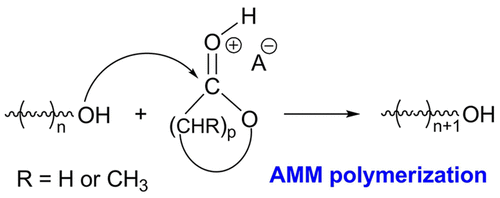当前位置:
X-MOL 学术
›
ACS Macro Lett.
›
论文详情
Our official English website, www.x-mol.net, welcomes your
feedback! (Note: you will need to create a separate account there.)
Activated Monomer Mechanism (AMM) in Cationic Ring-Opening Polymerization. The Origin of the AMM and Further Development in Polymerization of Cyclic Esters
ACS Macro Letters ( IF 5.1 ) Pub Date : 2021-10-19 , DOI: 10.1021/acsmacrolett.1c00509 Stanislaw Penczek 1 , Julia Pretula 1
ACS Macro Letters ( IF 5.1 ) Pub Date : 2021-10-19 , DOI: 10.1021/acsmacrolett.1c00509 Stanislaw Penczek 1 , Julia Pretula 1
Affiliation

|
The origin of the activated monomer mechanism (AMM) in cationic ring-opening polymerization (CROP) is described first. Then, conditions leading to the active chain end (ACE) mechanism and AMM are compared, as well as methods allowing to distinguish between these two mechanisms. These methods are based on the “ion trapping” of the active ionic species using highly basic phosphines or by comparing ACE and AMM kinetics of polymerization. The major factors deciding on the actual mechanism include: basicity of the monomers, ring strain, and the presence of the protic additives in the reaction system. These factors are tabulated for major cyclic ethers and cyclic esters. The historically evolved subsequent steps of AMM in the polymerization of cyclic esters are described: from the first experiments with trialkyloxonium salts, precursors of protonic acids, and added alcohols, via HCl as catalyst, and then CF3S(═O)2OH (polymerizing lactides) to the most popular derivatives of phosphoric acid, like diphenyl phosphate. Conditions allowing to synthesize poly(ε-caprolactone) (PCL), according to AMM-CROP, with molar mass up to 105 g·mol–1, are described as well as methods to polymerize CL with a protic initiator and acidic catalyst in one molecule. Then various methods enhancing the activity of the polymerizing systems are compared, based predominantly on hydrogen bonding, either to the polymer active end group (usually the hydroxyl group) or to the acid anion. Finally, kinetic equations for ACE and AMM are compared, and it is shown that the majority of the AMM-CROP systems, mostly studied for CL and lactides, proceed as living/controlled polymerizations. Since polymer end groups are hydroxyl groups, then, as it was shown in several papers, any initiator with one or many hydroxyl groups provides macromolecules with the corresponding architecture. The papers on synthetic methods are not discussed in detail.
中文翻译:

阳离子开环聚合中的活化单体机理 (AMM)。AMM的起源与环状酯聚合的进一步发展
首先描述了阳离子开环聚合(CROP)中活化单体机理(AMM)的起源。然后,比较导致主动链端(ACE)机制和 AMM 的条件,以及允许区分这两种机制的方法。这些方法基于使用强碱性膦或通过比较 ACE 和 AMM 聚合动力学对活性离子物质的“离子捕获”。决定实际机理的主要因素包括:单体的碱度、环应变以及反应体系中质子添加剂的存在。这些因素针对主要的环醚和环酯列在表格中。描述了 AMM 在环酯聚合中历史上发展的后续步骤:从使用三烷基氧鎓盐的第一次实验开始,3 S(=O) 2 OH(聚合丙交酯)到最流行的磷酸衍生物,如磷酸二苯酯。根据 AMM-CROP,允许合成聚 (ε-己内酯) (PCL) 的条件,摩尔质量高达 10 5 g·mol –1,以及在一个分子中用质子引发剂和酸性催化剂聚合 CL 的方法。然后比较各种提高聚合体系活性的方法,主要基于氢键,或者与聚合物活性端基(通常是羟基)或酸阴离子。最后,比较了 ACE 和 AMM 的动力学方程,结果表明大多数 AMM-CROP 系统,主要针对 CL 和丙交酯进行研究,以活性/受控聚合的形式进行。由于聚合物端基是羟基,因此,正如几篇论文中所述,任何具有一个或多个羟基的引发剂都可以为大分子提供相应的结构。关于合成方法的论文没有详细讨论。
更新日期:2021-11-16
中文翻译:

阳离子开环聚合中的活化单体机理 (AMM)。AMM的起源与环状酯聚合的进一步发展
首先描述了阳离子开环聚合(CROP)中活化单体机理(AMM)的起源。然后,比较导致主动链端(ACE)机制和 AMM 的条件,以及允许区分这两种机制的方法。这些方法基于使用强碱性膦或通过比较 ACE 和 AMM 聚合动力学对活性离子物质的“离子捕获”。决定实际机理的主要因素包括:单体的碱度、环应变以及反应体系中质子添加剂的存在。这些因素针对主要的环醚和环酯列在表格中。描述了 AMM 在环酯聚合中历史上发展的后续步骤:从使用三烷基氧鎓盐的第一次实验开始,3 S(=O) 2 OH(聚合丙交酯)到最流行的磷酸衍生物,如磷酸二苯酯。根据 AMM-CROP,允许合成聚 (ε-己内酯) (PCL) 的条件,摩尔质量高达 10 5 g·mol –1,以及在一个分子中用质子引发剂和酸性催化剂聚合 CL 的方法。然后比较各种提高聚合体系活性的方法,主要基于氢键,或者与聚合物活性端基(通常是羟基)或酸阴离子。最后,比较了 ACE 和 AMM 的动力学方程,结果表明大多数 AMM-CROP 系统,主要针对 CL 和丙交酯进行研究,以活性/受控聚合的形式进行。由于聚合物端基是羟基,因此,正如几篇论文中所述,任何具有一个或多个羟基的引发剂都可以为大分子提供相应的结构。关于合成方法的论文没有详细讨论。











































 京公网安备 11010802027423号
京公网安备 11010802027423号